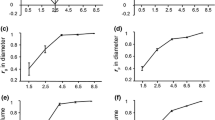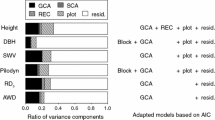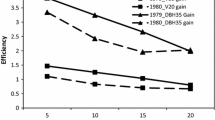Abstract
Unfavorable genetic correlations between growth and wood quality traits are one of the biggest challenges in advanced conifer breeding programs. To examine and deal with such correlation, increment cores were sampled at breast height from 5,618 trees in 524 open-pollinated families in two 21-year-old Norway spruce progeny trials in southern Sweden, and age trends of genetic variation, genetic correlation, and efficiency of selection were investigated. Wood quality traits were measured on 12-mm increment cores using SilviScan. Heritability was moderate (~0.4–0.5) for wood density and modulus of elasticity (MOE) but low (~0.2) for microfibril angle (MFA). Different age trends were observed for wood density, MFA, and MOE, and the lower heritability of MFA relative to wood density and MOE in Norway spruce contrasted with general trends of the three wood quality traits in pine. Genetic correlations among growth, wood density, MFA, and MOE increased to a considerably high value from pith to bark with unfavorable genetic correlations (−0.6 between growth and wood density, −0.74 between growth and MOE). Age–age genetic correlations reached 0.9 after ring 4 for diameter at breast height (DBH), wood density, MFA, and MOE traits. Early selections at ring 10 for diameter and at ring 6 or 7 for wood quality traits had similar effectiveness as selection conducted at reference ring 15. Selection based on diameter alone produced 19.0 % genetic gain in diameter but resulted in 4.8 % decrease in wood density, 9.4 % decrease in MOE, and 8.0 % increase in MFA. Index selection with a restriction of no change in wood density, MOE, and MFA, respectively, produced relatively lower genetic gains in diameter (16.4, 12.2, and 14.1 %, respectively), indicating such index selection could be implemented to maintain current wood density. Index selection using economic weights is, however, recommended for maximum economic efficiency.



Similar content being viewed by others
References
Baltunis BS, Wu HX, Powell MB (2007) Inheritance of density, microfibril angle, and modulus of elasticity in juvenile wood of Pinus radiata at two locations in Australia. Can J For Res 37(11):2164–2174. doi:10.1139/x07-061
Baltunis BS, Gapare WG, Wu HX (2010) Genetic parameters and genotype by environment interaction in radiata pine for growth and wood quality traits in Australia. Silvae Genet 59:113–124
Berlin M, Lönnstedt L, Jansson G, Danell Ö, Ericsson T (2010) Developing a Scots pine breeding objective: a case study involving a Swedish sawmill. Silva Fenn 44(4):643–656
Bouffier L, Raffin A, Rozenberg P, Meredieu C, Kremer A (2009) What are the consequences of growth selection on wood density in the French maritime pine breeding programme? Tree Gene Genom 5:11–25. doi:10.1007/s11295-008-0165-x
Bridgwater FE, Talbert JT, Jahromi S (1983) Index selection for increased dry weight in a young Loblolly pine population. Silvae Genet 32:157–161
Burdon R (1977) Genetic correlation as a concept for studying genotype-environment interaction in forest tree breeding. Silvae Genet 26:168–175
Burdon RD, Kibblewhite RP, Walker JCF, Megraw RA, Evans R, Cown DJ (2004) Juvenile versus mature wood: a new concept, orthogonal to corewood versus outerwood, with special reference to Pinus radiata and P. taeda. For Sci 50(4):399–415
Dadswell HE, Fielding JM, Nicholls JWP, Brown AG (1961) Tree-to-tree variations and the gross heritability of wood characteristics of Pinus radiata. TAPPI 44:174–179
Evans R (1999) A variance approach to the X-ray diffractometric estimation of microfibril angle in wood. Appita J 52(4):283–289
Evans R, Ilic J (2001) Rapid prediction of wood stiffness from micrfibril angle and density. For Prod J 51:53–57
Evans R (2006) Wood stiffness by X-ray diffractometry. In: Stokke DD, Groom HL (eds) Characterization of the cellulosic cell wall. Wiley, Hoboken, pp 138–146
Falconer D, Mackay T (1996) Introduction to quantitative genetics, 4th edn. Longman, New York
Fielding JM (1953) Variation in Monterey pine. Forestry and Timber Bureau, Australia Bulletin No.31. 43 p
Fielding JM, Brown AG (1960–61) Variations in the density of the wood of Monterey pine from tree to tree. For Timber Bur Leafl 77:1–28
Gapare WJ, Wu HX, Abarquez A (2006) Genetic control of the time of transition from juvenile to mature wood in Pinus radiata D. Don. Ann For Sci 63(8):871–878
Gapare WJ, Matheson AC, Ivković M, Baltunis BS, Wu HX (2010) Genetic stability of wood density in Pinus radiata D. Don plantation estate across Australia. Tree Gene Genom 6:113–125
Gilmour AR, Gogel B, Cullis B, Thompson R (2009) ASReml user guide release 3.0. VSN International Ltd, Hemel Hempstead
Gräns D, Hannrup B, Isik F, Lundqvist S-O, McKeand S (2009) Genetic variation and relationships to growth traits for microfibril angle, wood density and modulus of elasticity in a Picea abies clonal trial in southern Sweden. Scand J For Res 24(6):494–503. doi:10.1080/02827580903280061
Gwaze DP, Bridgwater FE, Byram TD, Lowe WJ (2001) Genetic parameter estimates for growth and wood density in loblolly pine (Pinus taeda L). For Genet 8(1):47–55
Gwaze D, Harding K, Purnell R, Bridgwater F (2002) Optimum selection age for wood density in loblolly pine. Can J For Res 32(8):1393–1399
Hallingbäck HR, Sánchez L, Wu HX (2014) Single versus subdivided population strategies in breeding against an adverse genetic correlation. Tree Gene Genom. doi:10.1007/s11295-014-0707-3
Hannrup B, Cahalan C, Chantre G, Grabner M, Karlsson B, Bayon IL, Jones GL, Müller U, Pereira H, Rodrigues JC, Rosner S, Rozenberg P, Wilhelmsson L, Wimmer R (2004) Genetic parameters of growth and wood quality traits in Picea abies. Scand J For Res 19(1):14–29. doi:10.1080/02827580310019536
Hong Z, Fries A, Wu HX (2014) High negative genetic correlations between growth traits and wood properties suggest incorporating multiple traits selection including economic weights for the future Scots pine breeding programs. Ann For Sci 71:463–472. doi:10.1007/s13595-014-0359-3
Hylen G (1997) Genetic variation of wood density and its relationship with growth traits in young Norway spruce. Silvae Genet 46(1):55–60
Ivković M, Wu HX, McRae TA, Powell MB (2006) Developing breeding objectives for radiata pine structural wood production. I. Bioeconomic model and economic weights. Can J For Res 36(11):2920–2931
Ivković M, Wu HX, Kumar S (2010) Bio-economic modeling as a method for determining economic weights for optimal multiple-trait tree selection. Silvae Genet 59:77–90
Karlsson B, Rosvall O (1993) Progeny testing and breeding strategies. Proceedings of the Nordic group for tree breeding. Edinburgh
Kempthorne O, Nordskog AW (1959) Restricted selection indices. Biometrics 15(1):10–19. doi:10.2307/2527598
Klein TW (1974) Heritability and genetic correlation: statistical power, population comparisons, and sample size. Behav Genet 4(2):171–189. doi:10.1007/bf01065758
Lenz P, Cloutier A, MacKay J, Beaulieu J (2010) Genetic control of wood properties in Picea glauca—an analysis of trends with cambial age. Can J For Res 40(4):703–715. doi:10.1139/X10-014
Lenz P, MacKay J, Rainville A, Cloutier A, Beaulieu J (2011) The influence of cambial age on breeding for wood properties in Picea glauca. Tree Gene Genom 7(3):641–653. doi:10.1007/s11295-011-0364-8
Lenz P, Auty D, Achim A, Beaulieu J, Mackay J (2013) Genetic improvement of white spruce mechanical wood traits—early screening by means of acoustic velocity. Forests 4(3):575–594
Li L, Wu HX (2005) Efficiency of early selection for rotation-aged growth and wood density traits in Pinus radiata. Can J For Res 35:2019–2029
Louzada JLPC (2003) Genetic correlations between wood density components in Pinus pinaster Ait. Ann For Sci 60:285–294
Mrode R, Thompson R (2005) Linear models for the prediction of animal breeding values. CABI, UK
Panshin AJ, De Zeeuw C (1980) Textbook of wood technology: structure, identification, uses, and properties of the commercial woods of the United States and Canada, 4th edn. New York, McGraw-Hill
Pot D, Chantre G, Rozenberg P, Rodrigues JC, Jones GL, Pereira H, Hannrup B, Cahalan C, Plomion C (2002) Genetic control of pulp and timber properties in maritime pine (Pinus pinaster Ait). Ann For Sci 59:563–575
Rosvall O, Ståhl P, Almqvist C, Anderson B, Berlin M, Ericsson T, Eriksson M, Gregorsson B, Hajek J, Hallander J, Högberg K, Jansson G, Karlsson B, Kroon J, Lindgren D, Mullin T, Stener L. 2011. Review of the Swedish tree breeding programme. Skogforsk Internal Report
Rozenberg P, Cahalan C (1997) Spruce and wood quality: genetic aspects (a review). Silvae Genet 46:270–279
Skrøppa T, Hylen G, Dietrichson J (1999) Relationships between wood density components and juvenile height growth and growth rhythm traits for Norway spruce provenances and families. Silvae Genet 48(5):235–238
Steffenrem A, Kvaalen H, Høibø OA, Edvardsen ØM, Skrøppa T (2009) Genetic variation of wood quality traits and relationships with growth in Picea abies. Scand J For Res 24(1):15–27
Vargas-Hernandez J, Adams WT (1991) Genetic variation of wood density components in young coastal Douglas-fir: implications for tree breeding. Can J For Res 21(12):1801–1807. doi:10.1139/x91-248
White TL, Adams WT, Neale DB (2007) Forest genetics. CABI, Wallingford
Wu HX, Sanchez L (2011) Effect of selection method on genetic correlation and gain in a two-trait selection scheme. Aust For 74(1):36–42. doi:10.1080/00049158.2011.10676344
Wu HX, Powell MB, Yang JL, Ivković M, McRae TA (2007) Efficiency of early selection for rotation-aged wood quality traits in radiata pine. Ann For Sci 64(1):1–9
Wu HX, Ivković M, Gapare WJ, Baltunis BS, Powell MB, McRae TA (2008) Breeding for wood quality and profit in radiata pine: a review of genetic parameters. N Z J For Sci 38(1):56–87
Yanchuk A, Sanchez L (2011) Multivariate selection under adverse genetic correlations: impacts of population sizes and selection strategies on gains and coancestry in forest tree breeding. Tree Gene Genom 7(6):1169–1183. doi:10.1007/s11295-011-0404-4
Zhang SY, Morgenstern EK (1995) Genetic variation and inheritance of wood density in black spruce (Picea mariana) and its relationship with growth: implications for tree breeding. Wood Sci Technol 30(1):63–75. doi:10.1007/bf00195269
Zobel BJ, Jett J (1995) Genetics of wood production. Springer, Berlin
Zobel BJ, Van Buijtenen JP (1989) Wood variation: its causes and control. Springer, Berlin
Acknowledgments
The samples were collected in Skogforsk’s operative breeding experiments and managed by Johan Malm and other technical staff with funding from the Swedish Spruce Genome Sequencing project. The comprehensive set of wood quality data was produced at Innventia within the strategic research program Bio4Energy, funded by the Swedish government. The samples were prepared and analyzed by Åke Hansson, Thomas Trost, and other researchers, and Thomas Grahn organized the data in the Bio4Energy Trait Database for the later steps of the evaluation.
Data Archiving Statement
The raw quantitative traits data from SilviScan are currently archived in Innventia AB database, and the accession numbers will be supplied for further use of the data for collaboration.
Author information
Authors and Affiliations
Corresponding author
Additional information
Editorial Responsibility J. Beaulieu
Rights and permissions
About this article
Cite this article
Chen, ZQ., Gil, M.R.G., Karlsson, B. et al. Inheritance of growth and solid wood quality traits in a large Norway spruce population tested at two locations in southern Sweden. Tree Genetics & Genomes 10, 1291–1303 (2014). https://doi.org/10.1007/s11295-014-0761-x
Received:
Revised:
Accepted:
Published:
Issue Date:
DOI: https://doi.org/10.1007/s11295-014-0761-x




